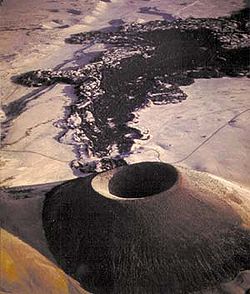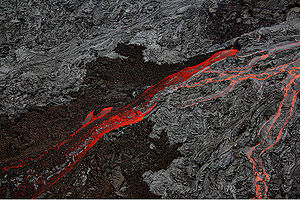Volcano Fields
Introduction
Volcano fields are unique ecosystems found around the world’s active volcanoes. A volcano field usually encompasses any number of active volcanoes clustered together in relatively close quarters. These environments are characterized by magma and ash as soil parent material and often exhibit early stages of succession in an ecosystem. Frequent disturbance of volcanic activity can prevent succession from proceeding to high orders. These eruptions can produce or displace magma, rock, or ash, depending on unique characteristics of every volcano or eruption event.
These areas are quite special because they represent the spearhead of geologic time. Materials from the earth’s inner layers are introduced to the lithosphere and atmosphere, which can cause interesting phenomena among microbial populations.
The microbial populations found in such areas are categorized by their abilities to process the new or changed materials on the earth’s surface. Although disturbance is high right near the source of magma and ash flows, these flows do not always cover an area completely, which provides physical, chemical, and biological diversity between and across sites near a volcano.
Microorganisms that occupy these areas are typically extremophiles that tolerate high heat, and are often oxidize CO and utilize methanogenesis. These early processes help prepare the lava and ash deposits to be suitable to support higher life forms.
Physical environment
The physical environment of a volcano field is somewhat diverse, as the materials present can come from lava flows, or ash flows. Also, they change dramatically over time due to microbial and atmospheric weathering processes.
Very high concentrations of silicates cause lava to be an acidic environment, suitable for acidophiles, while less acidic flows are represented by a lower concentration of silicate material.
Microorganisms colonize recent volcanic deposits and are able to establish diverse communities, their composition is governed by variations in local deposit parameters.
Along with solid and liquid rock material ejected by volcanoes, many gases are ejected and are often trapped in the solids on the ground once the lava cools. These gases can be used by microbes for gas exchange and metabolic processes. Methane, for example, is common in erupted material, and is used by methanotrophic bacteria for energy and carbon uptake.
Lava Flows
A brand new lava flow is likely to have a high concentration of silicate, with significant amounts of aluminum, potassium, sodium, and calcium found throughout. Differences in silicate concentrations affect the viscosity of the medium, changing the manner of eruption, flow, and after-effects.
Mafic Lava
Mafic, or basaltic, lava is high in iron and magnesium and lower in aluminum and silicates. This lava is not very viscous, so it often cools with smooth yet rippled surface patterns, as opposed to blocky and jagged Felsic deposits.
Felsic Lava
Felsic lava is very viscous, and has a higher concentration of silicate material, and produces a very blocky pattern as it cools.
Ash Flows
An ash flow is a typical eruption of highly gaseous magma. The large amount of gas causees eruptions to be explosive, launching ash and debris very high into the air. The ash and debris will fall to the ground near the volcano (sometimes a few miles away) and supply the microbes with a fresh source of minerals to metabolize for energy.
Physical Succession
Succession from bare lava flow to forest occurs over time, as living things, from microbes to animals, change the landscape by living in and around it. Microbes are always present first because certain types are able to withstand the extreme heat involved with lava flows.
Chemolithoautotrophs use the materials in recent lava flows for energy first(the earliest users being thermophiles). Breakdowns cause soils to start to form, allowing plant life to establish. Plant life will draw in animal grazers, which both help the soil develop further by physically altering its structure.
Biological interactions
Important biological interactions in volcano fields are quite like many other ecosystem, like the microbes and fungi allowing plants to utilize nutrients that would be otherwise inaccessible. A major difference in succession and early interactions in a volcano field come from the extremely high intensity of disturbances. Lava and ash eruptions can cause catastrophic damage to an ecosystem, often forcing succession to start over.
Once microbes change the soils to support plant life, plants will be able to grow and reproduce, which allows the primary succession plants to immigrate to the newly formed soils. When plants establish, their roots can break up the volcanic deposits, allowing more atmospheric interactions to shape the composition and structure of the soils. When more air is present in the volcanic soils, more microbial activity can take place due to the increased gas exchange capabilities.
When plant life has established itself in an area, there will almost always be animal life to use the plants for food. Herbivores will spread the microbes and plant seeds, allowing travel of such organisms to increase, which can increase the beta diversity of the field.
Microbial processes
According to the Kilauea Volcano Microbial Observatory, Carbon monoxide oxidation and methanotrophy are two major processes that shape the chemical makeup of a volcano field.
CO Oxidation
Methanotrophy
Methanotrophs are able to use methane as their primary source of carbon and energy.
Key Microorganisms
What kind of microbes do we typically find in this environment? Or associated with important processes in this environment? Describe key groups of microbes that we find in this environment, and any special adaptations they may have evolved to survive in this environment. Add sections/subsections as needed. Look at other microbe listings in MicrobeWiki. Are some of the groups of microbes from your environment already described? Create links to those pages. Specific microbial populations will be included in the next section.
Subsection 1
Subsection 1a
Subsection 1b
Subsection 2
Examples of organisms within the group
Pseudomonas
Burkholderia
Mycobacterium
Current Research
Enter summaries of recent research here--at least three required
http://www.biology.lsu.edu/kmo/forms/King-Crosby.pdf
http://www.biology.lsu.edu/kmo/forms/GMKanoxicCOox.pdf
http://www.biology.lsu.edu/kmo/forms/Nanbaetal04.pdf
References
Volcanic Gases and Their Effects
Distribution, diversity and ecology of aerobic CO-oxidizing bacteria
Edited by student of Angela Kent at the University of Illinois at Urbana-Champaign.


